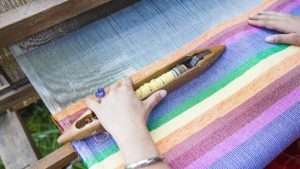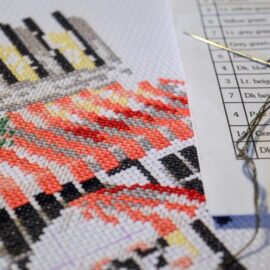Dry, cracked hands are crying out for a good care regimen. Stitchers & crafters, we’ve got you covered.
 Dry hands with chapped skin, ragged cuticles, jagged nail edges, and roughened calluses can seriously detract from an enjoyment of hand crafts. This is especially true for those of us who love working with fibers. Yarns and flosses are notorious for catching on patches hangnails and dry skin patches. They snag on rough cuticles and chipped nails. And while this is true for most fibers, it’s most acutely so for silks, which fray and snarl if you so much as look at them too sternly. And we’re sorry to have to admit it, but dry skin problems just get worse as your skin ages and natural collagen and elastin levels drop.
Dry hands with chapped skin, ragged cuticles, jagged nail edges, and roughened calluses can seriously detract from an enjoyment of hand crafts. This is especially true for those of us who love working with fibers. Yarns and flosses are notorious for catching on patches hangnails and dry skin patches. They snag on rough cuticles and chipped nails. And while this is true for most fibers, it’s most acutely so for silks, which fray and snarl if you so much as look at them too sternly. And we’re sorry to have to admit it, but dry skin problems just get worse as your skin ages and natural collagen and elastin levels drop.
Dry hands can be caused by exposure to harsh chemicals, though weather and indoor environments have effects, as do our lifestyle choices. Diet, exercise, weight gain or loss, hygiene, and stress can contribute to dry, flaking skin.
As stitchers, stopping in mid-flow to treat dry hands is a nuisance. Skin takes time to absorb hand creams and lotions, and we don’t always want to wait! But thanks to modern formulations for hand lotions, we’ve even got some relief! Even a brief web search turns up a good list of products—look for the ones recommended by stitchers, for stitchers!
We don’t recommend using most popular commercial lotions while working with fibers. Ingredients like lanolin, shea butter, and even coconut butter combine with skin oils, and will oxidize if left on fibers. Yellow stains and splotches on cross stitch and other embroidery projects don’t show up long weeks or months after it’s been finished and framed.
 Care for Dry Hands
Care for Dry Hands
So rather than waiting until you’ve got your dry, chapped hands full of needles and fabric to slap on the lotion, consider doing a quick hand care session before you sit down to stitch.
- Wash hands with mild soap or moisturizing hand wash and warm, not hot water. Water that is too hot dies out the skin.
- Apparently, the amount we drink is irrelevant to our skin’s ability to stay hydrated. Science tells us that a good moisturizer is what’s needed to combat dry, chapped hands. Look for lotions marketed “for stitchers” and include ingredients like stearic acid, ceramides, and topical cholesterol. If you must use heavier moisturizers, wait at least 15 minutes after applying before handling yarns, fabrics, or flosses.
- Run a high quality file over your nails to smooth out any burrs while you’re waiting! Consider investing in a good manicure/pedicure set to keep by your crafting station to treat skin and nail problems as they arise.
- After you’ve put your project away is a great time to moisturize those dry hands! Get a luxurious cream to massage into your hands as a reward for that beautiful work!
A good hand-care regimen is a definite win-win. It creates healthier hands and more time for cross stitch and crafting!
What are your favorite hand lotions? What other hand care products do you swear by? Leave a comment to share your favorites!

- Too Old for Snapchat Too Young for LifeAlert - November 2, 2023
- Fast 5: Ways to Destress Yourself with Cross Stitch! - October 31, 2023
- October 2023 is Menopause Awareness Month! - October 5, 2023


 Care for Dry Hands
Care for Dry Hands

